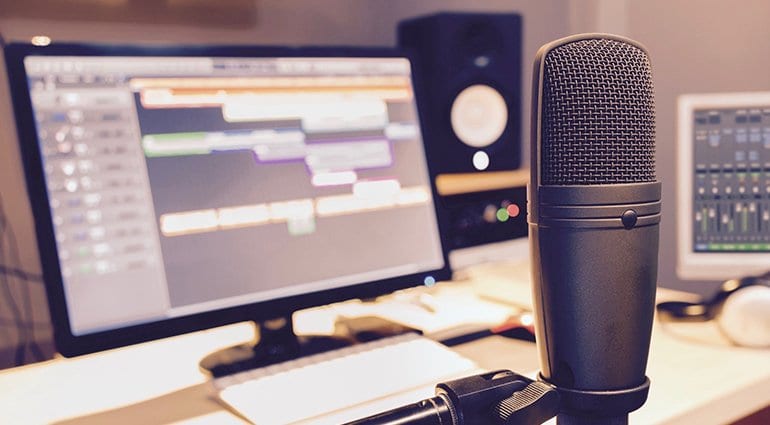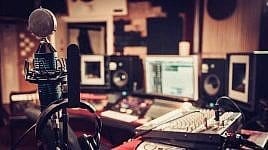
As you can tell from Thomann’s selection of microphones, there are many specialty mics out there for specific applications. But it is certainly nice to have two or three versatile mics that can cover various applications, if not all. If you are just starting to build up your gear setup then this might be a good place to start… ?
Considering the “All-Rounder”
The question quickly arises as to which microphone has the best all-round qualities. Many mics work well for vocals and spoken word but the guitar amp, acoustic guitar, woodwinds and brass instruments must also be recorded. Even drums can be recorded with a single microphone, if its placement is well studied.
Most likely, ten out of ten technicians will give ten different answers to this question: “Which single microphone would you bring to a deserted island?”. What this mic should be able to do is debatable. Very characteristic mics, for example ones with tubes as impedance converters and output transducers are a bit too “colourful” to be used for every source. The more neutral the better. Colour by harmonic distortion and the like can be added later if desired. Exceptions do exist: High quality tube mics, such as the Neumann M 149 Tube or the Brauner VM1, refine the sound, but above all do not interfere with the detail of the signal.
Switchable Flexibility
In order to be as flexible as possible, it is advisable to choose a mic with a polar pattern switch, one that can switch the mic’s directionality between cardioid, sub-cardioid, super-cardioid, hyper-cardioid, bidirectional and omnidirectional. Some microphones sound distinctly different depending on the pattern and this variety can be used consciously and strategically.
It is almost always the case that double-diaphragm microphones, which allow such a switch-over, are large diaphragm microphones. Among them are some with rather reserved sound and quite linear frequency response, like the Neumann TLM 170R, the AKG C414 XLS or the Audio-Technica AT4050. These are not cheap microphones, and for a reason: they can tolerate major changes in the mix well. This means that they should have a low noise and a late tug – over the entire frequency spectrum. This is rightly called a good “EQability” and “Compressability“.
- Neumann TLM 170R
- AKG C 414
- AT4050
It’s worth noting that large diaphragm microphones have the disadvantage of being slightly more directional when capturing high frequencies. This means that on-axis sources appear brighter than sound coming from the sides (off-axis). Also, impulse response on large diaphragm mics is not quite as good as on small diaphragm mics because the diaphragm mass is slightly heavier.
Modular diaphragm systems
Small diaphragm microphones are directionally better. Various capsule attachments are available for various straightening characteristics and these are called modular systems. The best known and, according to the opinion of many professionals, the best system is the Schoeps Colette, which scores with a remarkable frequency response and enormous resolution. The Oktava MK-012 or the AKG system with the CK capsules are popular too but cheaper.
- Schoeps Colette
- Oktava MK 012
- AKG SE 300 B
An advantage of small diaphragm mics is that they are true pressure receptors unlike double membranes ones. They have a very good noise reduction from the back and a nice low bass reproduction that the other microphones do not achieve. With a suitable space and proper sound engineering, a small diaphragm microphone can also take over the all-rounder task.
Small diaphragm mics are also exceptional in this aspect: All other mics amplify the bass frequencies when brought closer to the source causing an undesired “boomy” sound. This phenomenon is called the proximity effect. This effect is sometimes desired but most of the time it becomes too much. To reduce the proximity effect, some large diaphragm mics are equipped with a high-pass filter (also known as a “low cut”) switch.
Dynamic (or Moving Coil) microphone as an alternative
There are also engineers who swear by dynamic microphones alone. And indeed, together with a good preamp, great sound results can be obtained even though they are less detailed than condenser microphones. In addition, dynamic mics, which don’t have switches on them, do have something that condenser microphones don’t: a much higher maximum sound pressure level (Max SPL). This means that the sound will not distort when you are recording loud sources such as drums or tambourine.
For percussion, brass instruments and amplified guitar or bass, most condenser microphones will work fine. Unwanted distortion may be prevented with the pad and/or low cut switches, on most switchable condensers. With small diaphragm, there are sometimes small modules, which are used between the capsule and body instead of switching functions.
Our Conclusion
Actually, it is clear: a REAL all-rounder doesn’t exist! With a neutral-sounding, switchable large diaphragm microphone (with high-pass filter and pad), however, almost all standard tasks can be done.
However for certain applications, such as very high level signals, inconspicuous positioning, live performance and stereo recordings a large membrane mic is not ideal. This is where dynamic mics come into play.
A good option is to try to acquire a high-end microphone right from the beginning. If you have already made this investment, you have probably used this microphone for many years and have returned to it on more than one occasion.
#RecordYourself with the help of #HomeRecordingDays!

➡ Go to the article “Make portable recordings possible with these devices”
➡ Go to the article “8 placement tips to get the best out of your Studio Monitors”
➡ Go to the 5 microphone under 500€ comparison video
➡ 360° guided tour of our Studio department
➡ Go to our selection of Studio Microphones
➡ Browse our huge selection of Studio/Recording products on our Online Shop.
One comment
Leave a Reply
You are currently viewing a placeholder content from Facebook. To access the actual content, click the button below. Please note that doing so will share data with third-party providers.
More InformationYou are currently viewing a placeholder content from Instagram. To access the actual content, click the button below. Please note that doing so will share data with third-party providers.
More InformationYou are currently viewing a placeholder content from X. To access the actual content, click the button below. Please note that doing so will share data with third-party providers.
More Information











Richard Smith says:
Hi Joe. You haven’t had the joy of using INTEGRAL close miking yet by the look of things..